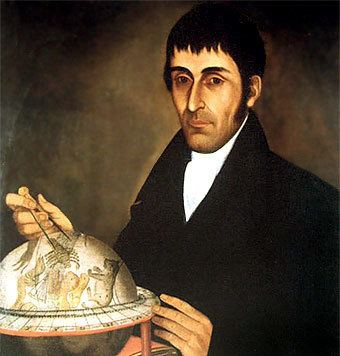Nationality Neogranadine Other name El Sabio ("the learned") | Education Del Rosario University | |
 | ||
Full Name Francisco José de Caldas y Tenorio Other names El Sabio ("the learned") Alma mater Our Lady of the Rosary University Died 28 October 1816, Bogotá, Colombia Parents José de Caldas y Gamba, Vicenta Tenorio y Arboleda Similar | ||
Francisco jos de caldas la amistad y la pasi n por conocer
Francisco José de Caldas (October 4, 1768 – October 28, 1816) was a Colombian lawyer, military engineer, self-taught naturalist, mathematician, geographer and inventor (he created the first hypsometer), who was executed by orders of Pablo Morillo during the Spanish American Reconquista for being a forerunner of the fight for the independence of New Granada (modern day Colombia).
Contents
- Francisco jos de caldas la amistad y la pasi n por conocer
- Universidad distrital francisco jos de caldas
- Early life
- Expeditionary
- Revolutionary
- Military
- Death
- Legacy
- Books
- References

Universidad distrital francisco jos de caldas
Early life

Caldas began his studies in the city of Popayán in the Seminary of Popayán. He later studied in the Colegio del Rosario graduating in Law but was also passionate for mathematics, astronomy and natural sciences.
Expeditionary

Caldas was part of several scientific expeditions including the ones with José Celestino Mutis and Alexander von Humboldt. Considering that he was situated in the relative backwater of Popayán, Humboldt was impressed with his scientific accomplishments. Caldas had developed a method to accurately measure altitude by recording the boiling temperature of water. Caldas gave Humboldt data on altitudes in the region, while Humboldt and botanist Aimé Bonpland, his scientific traveling partner, taught Caldas formal training in botany. Mutis appointed Caldas to the Botanical Expedition to Nueva Granada. He traveled across the New Kingdom of Granada exploring the newfound land, studying flora, fauna, geography, meteorology and cartography. In 1805 Caldas was appointed by Mutis to direct the Astronomic Observatory in Bogotá.
Revolutionary

Once the revolution of July 20, 1810 occurred, Caldas soon became the editor of the official state newspaper, the Diario Político. Upon Nariño's taking power in Cundinamarca in September 1811, Caldas was drafted as an engineer.
Military
In 1811, Caldas was appointed captain of the brand new Army Corps of Engineers, and by 1812, promoted to lieutenant colonel. In 1813 he was involved with the rebellion against Nariño. After being defeated in the rebellion, Caldas, fearing reprisals, went to Antioquia where he was conferred the rank of colonel and was appointed Director of Arms Factories and Engineer. Between 1813 and 1814, he took charge of the fortifications of the Cauca River and the installation of a rifle and gunpowder factory. In 1815, he was called to take charge of the creation of a military academy in New Granada, and the construction of batteries, trenches, and bridges in the vicinity of the capital. In late 1815, he was sent by José Fernández Madrid to serve in the Army of the North to fortify the roads.
Death
Caldas was captured by the Spanish royalists in 1816 and executed on October 29, in San Francisco Plaza by orders of Pablo Morillo, Count of Cartagena. When Caldas was about to be executed and the people present at the place appealed for the life of the scientist, Morillo responded: "Spain does not need savants" (Spanish: "España no necesita sabios"). Before dying Caldas wrote on the wall a large Greek letter θ, which has been interpreted as exclaiming "Oh long and dark departure!" (Spanish: ¡Oh larga y negra partida!
His body was buried in Veracruz Church, which was later turned into the Panteón Nacional (National Pantheon) but later moved to the Panteón de los Próceres in his hometown, Popayán.
Legacy
Caldas helped fund the New Kingdom of Granada Seminary, intended to be a scientific institution during the first decade of the 1800s. In 1810, he founded the Diario Político de Santa Fe Political Diary of Santa Fe which ultimately defended the independentist movement. During this time Caldas became engineer's colonel designing an artillery apparatus for the revolutionaries.
The Colombian department of Caldas is named for Francisco José de Caldas.
The “Francisco José de Caldas” Scholarship for Doctoral Programs is awarded by The Departamento Administrativo de Ciencia, Tecnología e Innovación (Colcienciasis) for Colombians to study toward a PhD.
